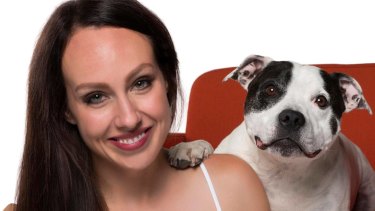Sick as a dog: This is probably why your dog has anxiety
There are about five million dogs in Australia and nearly 2.5 million of them have an anxiety disorder.
This is a fact that we may have scoffed at not so long ago, but as recent research into canine behaviour has found, our furry friends have feelings and fertile inner lives of their own.
Mental health is a “massive” problem in dogs, says animal behaviour expert, Laura Vissaritis
A study published in June found that dogs pick up on chronic stress and anxiety in their owners and have correspondingly elevated cortisol levels. A separate study, also published in June, found that dogs, which were domesticated by humans more than 33,000 years ago, have evolved muscles around their eyes to give them greater facial expression so they are better able to communicate with humans.
“MRIs of dogs have shown they have emotions, fear and anxiety like us,” says Laura Vissaritis, a “dognitive” therapist with a psychology degree in animal behaviour. “Mental health is a massive problem with dogs.”
Despite greater insights into the minds of dogs, many owners are neglecting their needs.
A new survey of dog owners by Guide Dogs Australia (GDA) found 70 per cent don’t walk their dogs daily, 13 per cent of which do not walk their dog at all, putting it down to a lack of time or poor weather.
This is creating physical health problems – somewhere between 41 per cent and 59 per cent of dogs are overweight or obese – as well as mental health problems.
“Around 40 per cent of dogs experience anxiety,” says Vissaritis, for whom business is “sadly” booming. "People are busier and they don’t have time and energy to invest in their dogs.”
Vissaritis, also the author of Dognitive Therapy, Things Your Dog Wants You To Know and The Rescue Dog, adds: “We know exercise is vital to the health and wellbeing of us. Dogs are the same.”
How much exercise a dog needs depends on its age, breed and personality she explains.
“For a greyhound – half an hour is enough. Kelpies on working farms however can run up to 50 kilometres a day,” says Vissaritis who owns a 10-year-old staffordshire bull terrier, Chester, and advises people to choose a dog that matches their lifestyle.
Laura Vissaritis with Chester.
For Pawgust, a month-long campaign in August, Guide Dogs Australia are encouraging owners to walk their dog for 30 minutes every day for 30 days.
Regardless of the breed, Vissaritis says half an hour is “a great start” and “anything is better than nothing”.
As well as helping your dog, research has found hanging out with pets and going for walks with them also alleviates our own stress and anxiety.
“People are going to realise, ‘I’m feeling much better and my dog is much better behaved’,” she says. “When your dogs are active they experience the same happy brain chemicals we do. It’s great for their physical wellbeing and their mental wellbeing.”
How do you know if your dog is anxious?
Vissaritis has created a dog happiness quiz for Pawgust, but says there are signs owners can look out for. “Get to know your dogs subtle body language and act on those subtle signs,” she advises. “They’re not being naughty to spite us – they’re just expressing themselves.”
- Constant scratching or digging up the backyard. “It can be fun but it can also be a sign of boredom or anxiety,” Vissaritis explains. “Typically if your dog is destructive, it’s an expression of their mental state.”
- Excessive barking or howling.
- Escaping the house when you’re at work or inappropriately urinating or defecating inside.
- Shaking or yawning are “usually” ways to relieve stress, Vissaritis says.
- Seeing the white in the corner of their eyes.
- Hanging their tail between their legs or wagging their tail to the left (wagging to the right is usually a sign of positive emotions).
How to help an anxious dog
“Most dog behaviour is about people,” says Vissaritis. So being aware of our own behaviour is important. Taking them for daily walks will help too. “If they pull it’s OK, if they want to stop and sniff every tree, that’s OK too,” she says.
For dogs that get anxious in public places because they can’t predict the environment, Vissaritis suggests taking a familiar mat or a towel that they have been trained at home to lie on to have their treats. “It’s a safe place and can help them calm down,” she explains, adding that they should also have a “safe place” inside at home that they can access when you are out.
“And create opportunities for them to explore inside and do mental exercise,” she suggests. “Hide high value dog food – like roast chicken – in treat dispensers at home or do trick training during ad breaks. Get to know who your dog is and make some changes in your life.”
Source: Read Full Article


